CWCI’s latest injury score card provides detailed data on California workers’ compensation carpal tunnel claims from accident years 2001 through 2011.


CWCI’s latest injury score card provides detailed data on California workers’ compensation carpal tunnel claims from accident years 2001 through 2011.

Updated figures from CWCI research show continued growth in average amounts paid for medical services in California workers’ comp, with payments for treatment, prescriptions and durable medical equipment, med-legal reports and medical management all trending up.
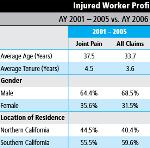
CWCI’s latest Injury Score Card provides detailed data and graphics on California work injury claims involving degenerative, infective and metabolic joint disorders. Members and subscribers may log in to view the full Score Card and summary Bulletin.
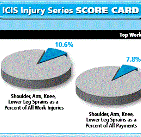
The latest CWCI Injury Scorecard takes a detailed look at California workers’ compensation claims involving shoulder, arm, knee, and lower leg sprains using data from 236,567 open and closed claims from AY 2001-2011.

An update to the CWCI analysis on the use of Schedule II painkillers in Calif workers’ comp suggests that that the use of these drugs peaked later than initially indicated, with revised data showing Schedule II opioids fell from a record 6.7% of workers’ comp prescriptions in the 2nd quarter of last year to 4.9% of the prescriptions in the 4th quarter.
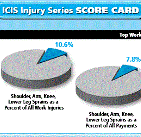
The latest CWCI Injury Score Card examines head and spinal injuries without spinal cord involvement, which comprise only a small percentage of claims, but account for only a small percentage of California workers’ compensation claims, but a disproportionate share of paid losses.
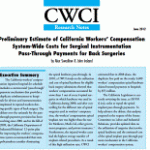
Duplicate payments to hospitals allowed by the California Workers’ Compensation Official Medical Fee Schedule for implantable hardware used in spinal surgery added an average of $20,137 in fees to more than 3,350 work injury claims in 2010, boosting workers’ compensation medical costs by nearly $67.5 million
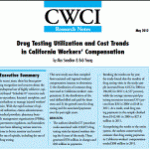
CWCI research measures the growing use of drug testing in California workers’ compensation, as well as the associated billings and payments.

CWCI research measures the growing use of drug testing in California workers’ compensation, as well as the associated billings and payments.
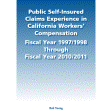
A new CWCI Report to the Industry looks at trends in California public self-insured claims experience using state data to track changes in public self-insured employers’ aggregate losses, average amounts paid and incurred per claim and claim volume over the past decade, with results measured at the first through 5th report levels. The Report is posted in the Research section.